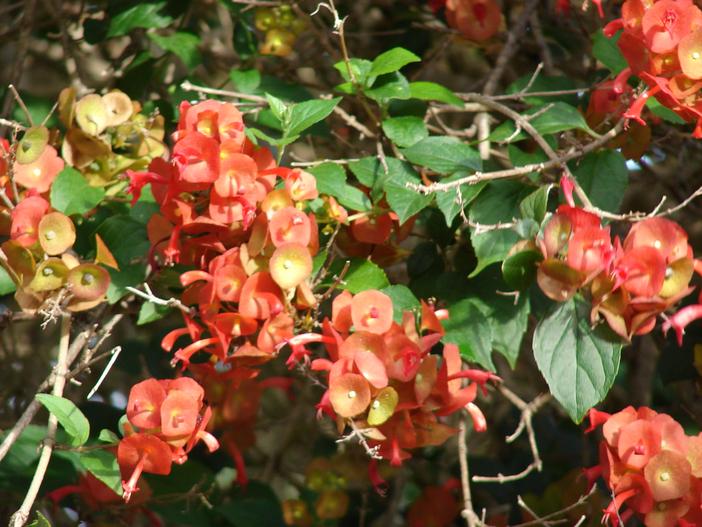Chinese Hat Plant
(Holmskioldia sanguinea)
Chinese Hat Plant (Holmskioldia sanguinea)
/
/

Forest and Kim Starr
CC BY 2.0
Image By:
Forest and Kim Starr
Recorded By:
Copyright:
CC BY 2.0
Copyright Notice:
Photo by: Forest and Kim Starr | License Type: CC BY 2.0 | License URL: https://creativecommons.org/licenses/by/2.0/ | Uploader: Starr Environmental | Publisher: Flickr




































Estimated Native Range
Summary
Holmskioldia sanguinea, commonly known as Chinese Hat Plant, is an evergreen perennial that can grow as a vine or shrub. It is native to the Himalayas and found in open woodlands and scrub areas of the Indian Subcontinent, including Nepal and Bhutan. This plant typically reaches a height and width of 4-8 feet (1.2-2.4 meters), with a sprawling habit that can be trained on supports or allowed to spread as ground cover. The Chinese Hat Plant is notable for its unique, brightly colored flowers that resemble small, inverted Chinese hats. The flowers are primarily orange but can also be found in shades of red or yellow, blooming profusely from summer to fall and attracting hummingbirds and butterflies.
The Chinese Hat Plant is valued for its distinctive flowers and ability to attract wildlife. It is used in tropical and subtropical gardens for ornamental purposes, including as a specimen plant, in mixed borders, or as a container plant. It requires full sun to part shade and prefers well-drained soil with moderate moisture, although it can tolerate drier conditions once established. Regular pruning can help maintain its shape and promote denser foliage. While generally pest-free, it can be susceptible to scale insects and mealybugs. The plant is not known for being invasive, but its rapid growth requires some maintenance to keep it under control.CC BY-SA 4.0
The Chinese Hat Plant is valued for its distinctive flowers and ability to attract wildlife. It is used in tropical and subtropical gardens for ornamental purposes, including as a specimen plant, in mixed borders, or as a container plant. It requires full sun to part shade and prefers well-drained soil with moderate moisture, although it can tolerate drier conditions once established. Regular pruning can help maintain its shape and promote denser foliage. While generally pest-free, it can be susceptible to scale insects and mealybugs. The plant is not known for being invasive, but its rapid growth requires some maintenance to keep it under control.CC BY-SA 4.0
Plant Description
- Plant Type: Shrub, Vine
- Height: 4-8 feet
- Width: 4-8 feet
- Growth Rate: Moderate
- Flower Color: Orange, Red, Yellow
- Flowering Season: Summer, Fall
- Leaf Retention: Evergreen
Growth Requirements
- Sun: Full Sun, Part Shade
- Water: Medium
- Drainage: Medium
Common Uses
Bee Garden, Border Plant, Butterfly Garden, Low Maintenance, Potted Plant
Natural Habitat
Native to open woodlands and scrub areas of the Himalayas and the Indian Subcontinent
Other Names
Common Names: Cup-And-Saucer-Plant , Mandarin’s-Hat , Mandarinhatt
Scientific Names: Holmskioldia sanguinea , Holmskioldia sanguinea f. citrina , Platunum rubrum , Hastingia coccinea , Hastingia scandens , Holmskioldia rubra , Holmskioldia sanguinea f. aurantiaca , Holmskioldia scandens
GBIF Accepted Name: Holmskioldia sanguinea Retz.